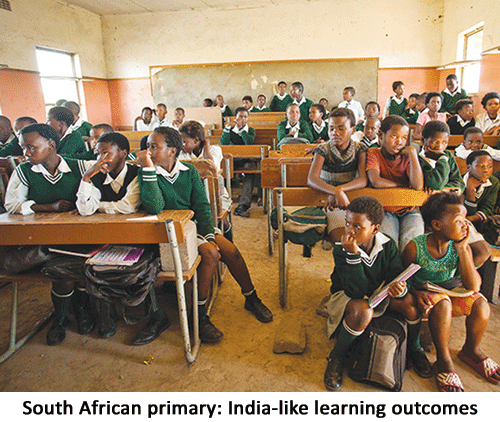 In a league table of education systems drawn up in 2015 by the OECD club of mainly rich countries, South Africa ranks #75 out of 76. Last November, the latest Trends in International Mathematics and Science Study (TIMSS), a quadrennial test written by 580,000 pupils in 57 countries, had South Africa at or near the bottom of its various rankings, though its scores improved since 2011.
In a league table of education systems drawn up in 2015 by the OECD club of mainly rich countries, South Africa ranks #75 out of 76. Last November, the latest Trends in International Mathematics and Science Study (TIMSS), a quadrennial test written by 580,000 pupils in 57 countries, had South Africa at or near the bottom of its various rankings, though its scores improved since 2011.
Its children are behind those in poorer parts of the continent. A shocking 27 percent of pupils who have attended school for six years cannot read, compared with 4 percent in Tanzania and 19 percent in Zimbabwe. After five years of school about half cannot work out that 24 divided by three is eight. Only 37 percent of children starting school go on to pass the matriculation exam; just 4 percent earn a degree — India-like learning outcomes.
Many of the problems have their roots in the apartheid era. The Bantu Education Act of 1953 set out to ensure that whites received better education than blacks, who were, according to Hendrik Verwoerd, the future prime minister then in charge of education, to be educated only enough to be “hewers of wood and drawers of water”. Black pupils received about a fifth of the funding of white peers. They were taught almost no maths or science. Most independent church-run schools that provided a good education in black areas were forcibly shut down.
After Nelson Mandela became president in 1994, his government expanded access to schooling. It also replaced a school system segregated by race with one divided by wealth. Schools in poorer areas receive more state funding. But schools in richer areas can charge fees on top.
And yet money is not the reason for the malaise. Few countries spend as much to so little effect. In South Africa, public spending on education is 6.4 percent of GDP; the average of EU countries is 4.8 percent. More important than money are a lack of accountability and the abysmal quality of teachers. Central to both failures is the South African Democratic Teachers Union (SADTU), which is allied to the ruling African National Congress (ANC).
The role of SADTU was laid bare in a report published in May 2016 by a team led by John Volmink, an academic. It found “widespread” corruption and abuse. This included teachers paying union officials for plum jobs, and female teachers being told they would be given jobs only in exchange for sex. The government has done little in response. Perhaps this is unsurprising; all six of the senior civil servants running education are SADTU members.
The union’s influence within government belies its claim that officials are to blame for woeful schools. In 2016, it successfully lobbied for the cancellation of standardised tests. It has ensured that inspectors must give schools a year’s notice before showing up (less than 24 hours is the norm in England). And although parent-led school governing bodies are meant to hold teachers to account, they are more often controlled by the union, or in some cases by gangs.
But even if there were better oversight most teachers would struggle to shape up. In a 2007 study, maths teachers of 11 and 12-year-olds sat for tests similar to those taken by their class; questions included simple calculations of fractions and ratios. A scandalous 79 percent of teachers scored below the level expected of pupils. The average 14-year-old in Singapore and South Korea performs much better.
Widespread improvement will require loosening the grip of SADTU. In local polls last August, the ruling party saw its worst results since the end of apartheid. This may force it to review vested interests. More likely, it will continue to fail children. “The desire to learn has been eroded,” says Angus Duffett, the head of Silikamva High. “That is the deeper sickness.”